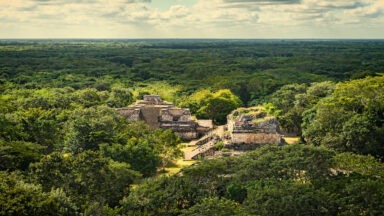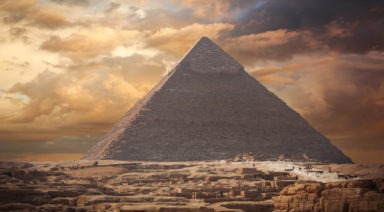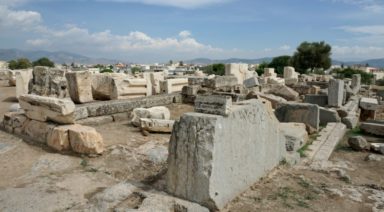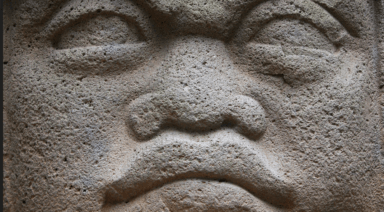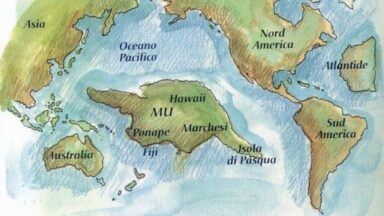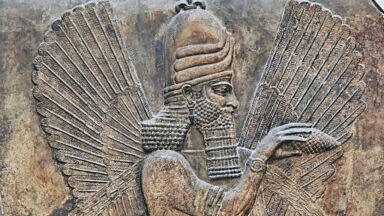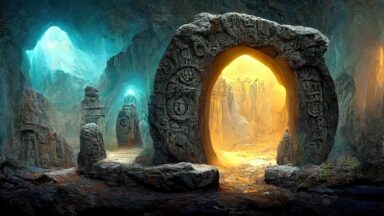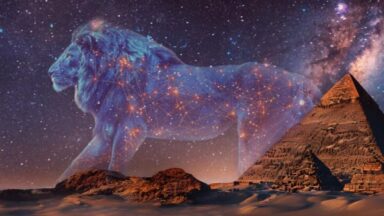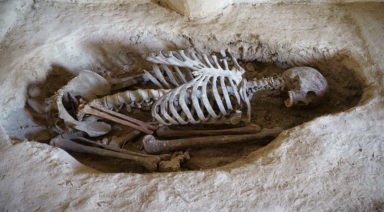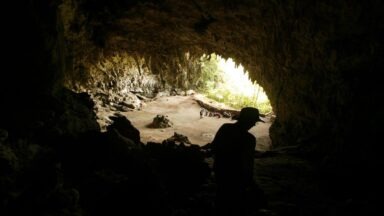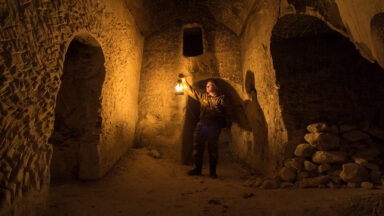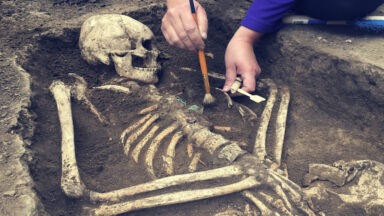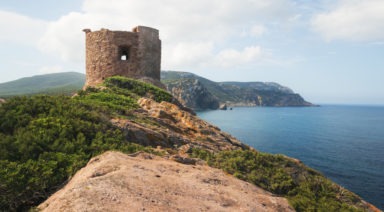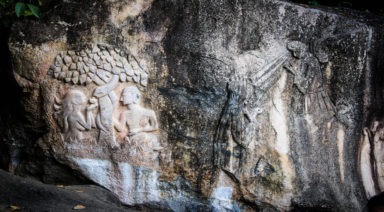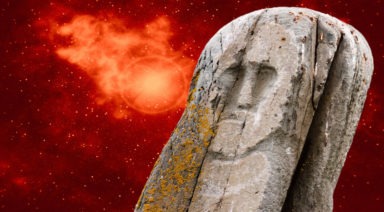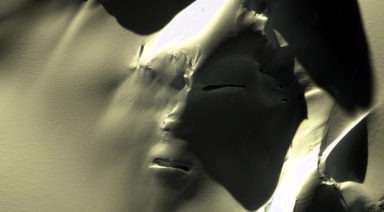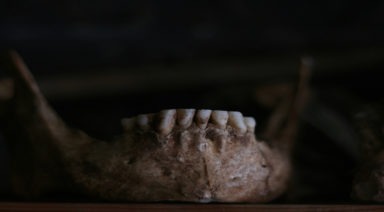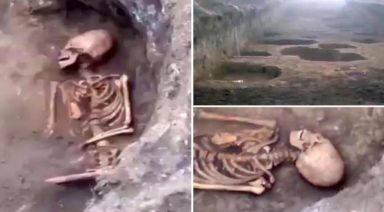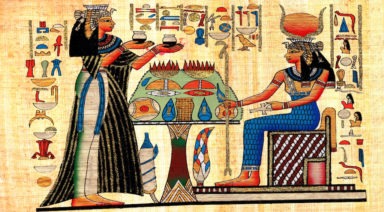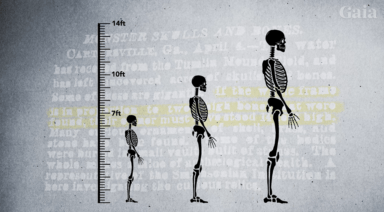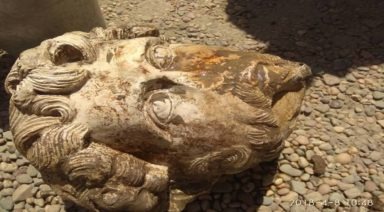Akhenaton: The Heretic Pharaoh
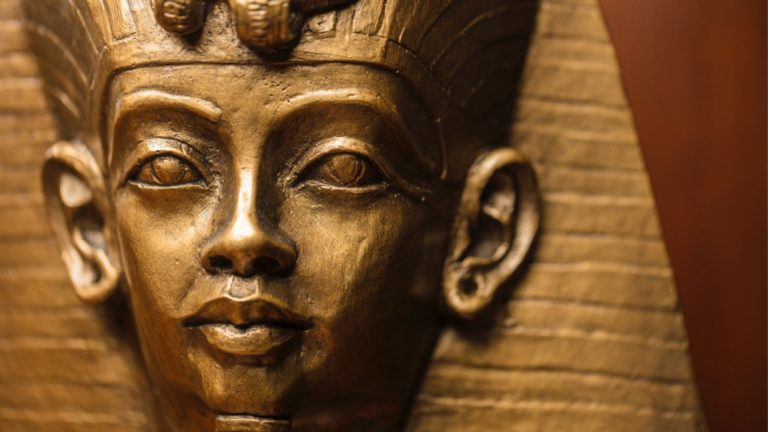
In the middle of a scorching desert, two hundred miles from the ancient city of Thebes, lay another ancient Egyptian city, intentionally forgotten, yet preserved by the arid climate. When archaeologists first came upon it in 1892, they were stunned, for this city was unmatched by Cairo, Thebes, Luxor, or any of the others they’d excavated. This city, as they would learn, was named Akhetaten, and its location was chosen not by any ruler, but by the life-giving power of the sun disc — the god Aten that presided over heaven and earth and all within them during the reign of Pharaoh Akhenaten.
From Pariah to King
Around the year 1380 B.C., Queen Tiye gave birth to King Amenhotep III’s second son, whom they named Amenhotep IV. Even with a devoted and doting mother, the child was regarded as a peculiar sort — possibly due to a physical deformity that left him with an elongated skull and exaggerated features, He was left out of public records and kept in the shadows when the royal family attended festivals and public events. Portraits of the family depict the pharaoh and chief queen with only five children — disregarding Amenhotep IV completely.
In spite of his perceived strangeness, Queen Tiye was determined for her son to one day rule their vast empire. When her first son, Thutmose, met an untimely death, the shunned Amenhotep IV emerged from the background to enjoy a co-regency with his frail father before seizing absolute power over the kingdom.
Amenhotep IV ascended the throne as the 10th king of the 18th dynasty, inheriting the great land of Egypt that his father had gently, yet firmly, ruled. At the time, it was widely believed that if Egypt’s many deities were worshiped and paid homage, food would be bountiful, the weather would remain fair, and peace would preserve the kingdom. And, indeed, Amenhotep III’s citizens kept their end of the bargain in their display of piety and reverence for the gods that lent their graces to each aspect of daily life. Archaeologists speculate that it was for this reason that Amenhotep II’s 38-year rule saw a peaceful, prosperous empire, with order among his many dutiful citizens and diplomacy with the empire’s bordering regions.
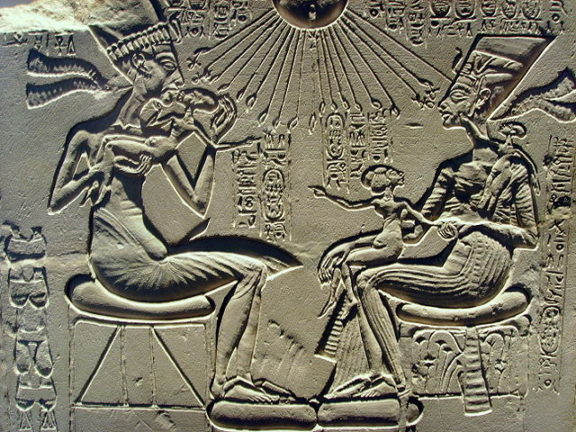
For some time after Amenhotep IV rose to power, life in ancient Egypt continued without much upset. The new pharaoh took the soon-to-be legendary beauty Nefertiti as his chief wife and continued to worship the traditional gods of his father’s kingdom, paying special homage to the sun god, Re-Harakhete, and the god Amun of Thebes. This, however, was all about to change.
The First Monotheistic Religion Is Born
Five years into his reign, Amenhotep IV ordered his builders to halt their work on a temple dedicated to Re-Harakhte, mid-construction. He then commissioned them to erect a new temple dedicated to the sun disc Aten.
Having only one form and not resembling either man or beast, the Aten was unlike any of the traditional gods of Ancient Egypt, making it difficult for the public to comprehend and embrace.
Indeed, the peculiar son of Amenhotep III had matured into an equally peculiar pharaoh. And perhaps it was because he had been so neglected in his youth and kept away from festivals celebrating the traditional deities that he developed less of an attachment to the idols that were held so dearly in the hearts of the populace. Unpopularly, Amenhotep had chosen a god of his own to worship, the Aten, and declared that it was the only god. Adding more fuel to the flames, he declared that neither his citizens nor anyone but he and Nefertiti were able to communicate with the Aten directly — making them history’s first monotheists. As Amenhotep IV reveled in his eminence, spiritually raised above the life he’d once been considered unworthy to live, the unrest among worshipers festered.
To further align himself with the sun disc, Amenhotep IV abandoned his given name in favor of Akhenaten, which translates to “Servant of the Aten,” marking the birth of a new religion. And with that, Akhenaton gathered his court and set off into the desert until his entourage was ordered to stop in a remote location, more than two hundred miles from Thebes. In this spot, he directed his crew to begin work, and his new capital soon rose from the dust. The pharaoh named it Akhetaten, or “Horizon of Aten,” after the line of cliffs overlooking the site formed the hieroglyph for “horizon.” It was a city where no other gods had yet been worshipped, and now it was home to Akhenaton’s one and only god.
It wasn’t long before Akhenaten taxed the temples of the old gods, forcing them to close and rendering dedicated priests listless and his disengaged populace unhappy. To explain his transition to a monotheistic cult, the pharaoh addressed his people in a sort-of state of the union speech discovered millennia later by archaeologists, “I know all about the gods,” he said. “But they have ceased, whether made of gold, silver, or precious stone. But my god is the uncreated creator; no man has crafted him.”
While Akhenaton never forbade his subjects from worshipping their pantheon, he had the names of all deities other than Aten removed from view. New temples continued to be built, but they now featured only the sun disc as the bringer of all life.
A New Artform
Akhenaten’s new religion gave rise to new art in a brief renaissance that turned traditional Egyptian style on its head. For the first time in history, portraits of the royal family depicted them as humans, instead of purely divine beings, with Akhenaten and Nefertiti engaged in daily life. Indeed, the pharaoh and his queen appear on numerous murals with their children upon their laps, receiving Aten’s blessings.
Perhaps most notable of Akhenaton’s artistic accomplishments was the swift transition of the formerly blocky Egyptian style to curving lines. This dramatic change could be observed in statues of the royal family, as well as in illustrations. Akhenaton himself was depicted as having overwhelmingly feminine traits in the majority of his renderings — to the extent that archaeologists have debated his gender. He shown as having androgynous features with wider hips, a round stomach, full lips, and even ample breasts. But even more striking to those beholding these unique renderings are that they clearly delineate the king’s long, cone-shaped head.
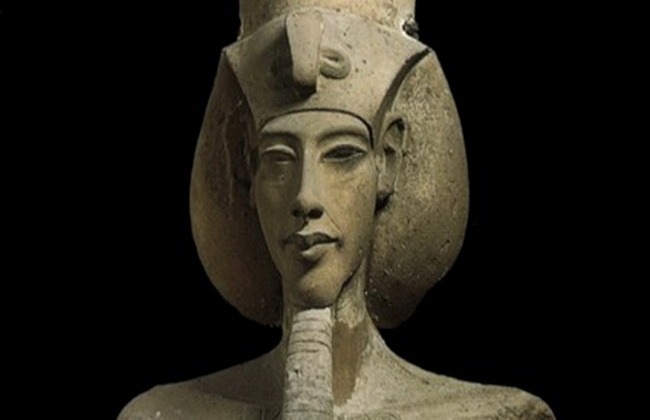
Akhenaton
Elongated Skulls
Experts have contemplated whether Akhenaton’s elongated skull was merely a stylistic canon, and depictions of his skull have served to further thicken the mystery shrouding the radical reign of this ancient king. Some scholars have interpreted his egg-shaped skull to be a symbol for spiritual rebirth or as a representation of his heightened state of consciousness. But it is also argued by myriad scholars that his skull’s proportions were, in fact, realistic. These so-called elongated skulls have been excavated not just from Ancient Egypt, but also from sites the world over, including the British Isles, Peru, Bolivia, and Germany.
The origin and cause of elongated skulls is unclear, though there is a spectrum of theories that ranging from deformative disease affecting the body’s normal growth to the fervent belief that elongated skulls are related to extraterrestrials.
The End of Akhenaton’s Confusing Era
Even though Akhenaton’s reign spanned no more than 17 years, he left his people reeling from his dramatic reforms.
Upon the pharaoh’s early death, his son Smenkhkare inherited the throne, succeeded shortly after by his nine-year-old brother Tutankhamun (later known as “King Tut”). Tutankamen, though he died a mere ten years into his reign, Tut did what he could to restore Egypt to its old ways, reviving the temples and the might of the Gods they honored. He reestablished Thebes as the kingdom’s religious center and the city Akhetaten was left to ruin at the mercy of the desert elements.
Akhenaton’s mortal remains body were mysteriously erased by the sands of time, and it uncertain if his sarcophagus was ever found — thus rendering the cause of his death unknown. During a 1907 dig in Akhetaten, archaeologists discovered a coffin containing a badly damaged mummy, but upon an attempt at closer examination, its bones crumbled to dust — perhaps a final punishment of the Gods upon this heretic king.
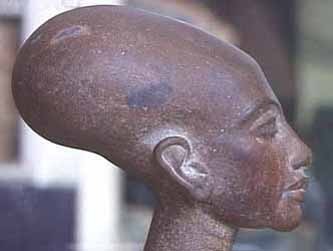
Elongated Egyptian Skull
Laser Scanning Reveals Mayan Complex Hidden for Centuries

Laser mapping reveals nearly 500 ancient ceremonial sites hiding just under the landscape of modern-day Mexico and leads scientists to revise their understandings of the origins of the Maya Civilization.
Eastern Mexico is home to the ancient Maya, renowned for their striking pyramids, written language, and complex calendar system. It is there that scientists first discovered Aquada Fénix, the largest and oldest-known Mayan construction.
Professor Takeshi Inomata is an archeologist at the University of Arizona who led the study. “We did LiDAR, which is an airborne laser marking technique. Using this technique we found Aguada Fénix, which is the oldest monumental construction in the Maya area,” Inomata said. “It has a huge artificial plateau which has a perfect, rectangular shape measuring 1.4 km long and 400m wide, which represents the largest construction in the entire Maya history. It dates to probably 1,100 – 700 BC, which makes it the oldest monumental construction in the Maya area. So the interesting part is that the largest building happened at the very beginning or oldest stage of Maya civilization.”
Having made this extraordinary find, the team recently expanded their search to a broader area using the same cutting-edge LiDAR technology. They were specifically hoping to find sites built by the Olmec people, an older civilization thought to have influenced the development of the Maya. What LiDAR revealed was groundbreaking.
“We found nearly 500 ceremonial complexes, which look like Aguada Fénix, although they are not as big. This distribution shows they shared similar concepts of space, ritual, and probably worldview. It tells us the people in the Olmec area and the Maya area really exchanged ideas and that kind of interaction was very important for the initial development of Mesoamerican civilizations,” Inomata said.
“This is the earliest evidence for the gathering of a really large number of people. Those people probably did not have too many hierarchical organizations, they most likely did not have kings. They didn’t have much marked social inequalities, so those people gathered and organized themselves, then made these huge constructions. This really makes us think about the development and possibility of human societies, not just about Mesoamerica, but about human societies in general.”


